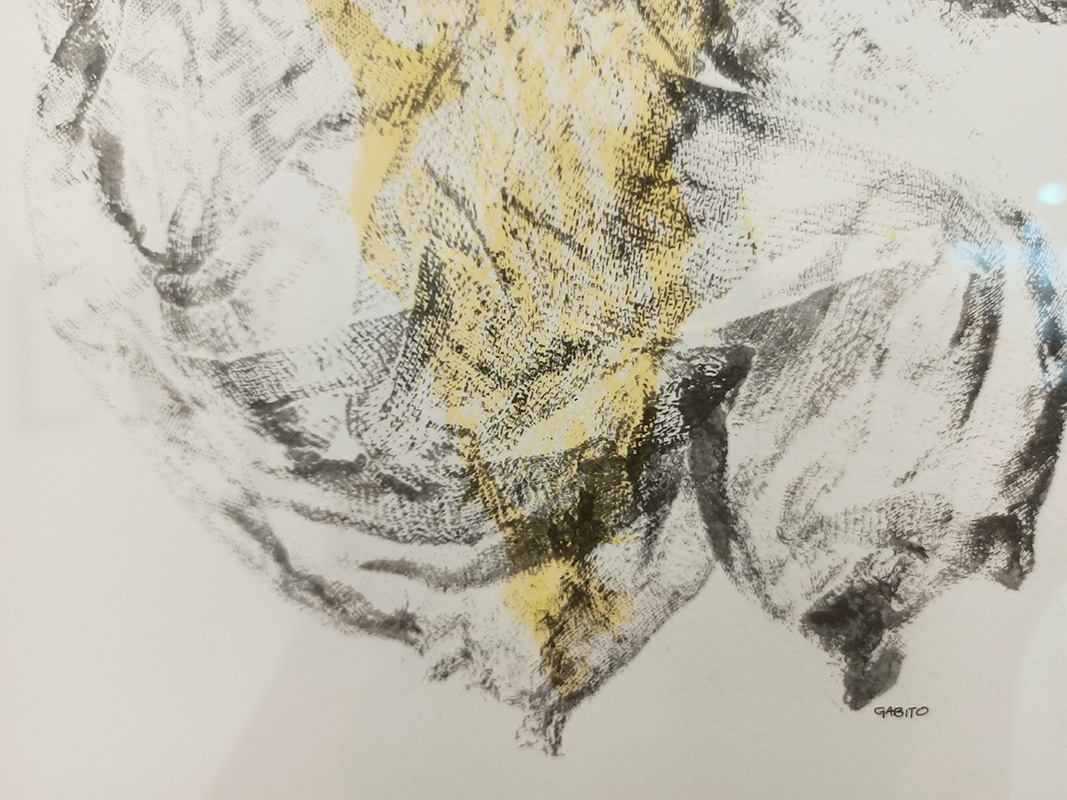When a work is stripped bare, one zooms in on the elements that remain present. Most apparent in Dino Gabito’s Threads are simply the cloth and its underlying structure, the weave. Each of the works, entitled Countour 1 through 14, nudges us to take notice of the forms cloth might take—scrunched, draped, or folded. The cloth works as a generator of abstraction—the possible shapes are nearly endless. It takes Gabito’s preoccupation with cloth to an almost rudimentary level—devoid of context, we focus on the material—the lines, layers, and opacity.
Gabito utilized the material subject—gauze—to dip into the pigment and print the forms on the paper. Instead of a drawing, or a simulation through painting, it is an imprint; it records the actual position of the material on paper, the weight of the folds marked by more pooling pigment. It captures the lines of the weave.
Gauze, a very loosely woven fabric, makes apparent the underlying structure of most cloth—woven into a grid. A grid can extend outward or inward, as reflected on by Rosalind Krauss, an art critic. A “centrifugal” reading goes outward—a grid is arbitrarily cut out of an infinitely larger grid. The centripetal reading goes inward—“a re-presentation of everything that separates the work of art from the world, from ambient space, and from other objects.” It then implies a continuity to a grid, as part of a bigger whole, and as a specific contained section.[1] Extending this logic to a piece of cloth, we can think of it as being cut out of a larger fabric; it is a bounded section, hemmed to prevent fraying, as if to keep the threads from reaching out.
As such, cloth can lend itself to illustrating a fragment of memory. It is a piece cut out of an infinitely larger ‘fabric of time’. Being flexible, it can bring together two points originally separated—hazy, distorted memory. Cloth is ubiquitous and universal. It contains meaning apart from its structure and material; it can quite literally hold history, a relic. Cloth found in archaeological sites can give insight into the civilizations that lived there thousands of years ago. Cloth in all forms like clothes can be passed down through generations, the objects of sentimentality and nostalgia. Cloth with its manifold function and form can contain associations, culture, feelings. These associations will likely be automatic—subconsciously, we can read the different crafting of the weave, fibers, weight, textures, and drape and assign their uses, settings, and contexts.
However, each individual will hold different memories, more personal and specific to their experience. Gabito’s gauze can be interpreted as a net, transforming the paper background into a seascape, capturing something imperceptible; it can be medical gauze, holding together a plaster cast and bandaging a fracture; it can be covered in ink, on a worktable, a crumpled printmaking tarlatan. As stated in the exhibition notes, gauze reminded the artist of lampin, the cloth diapers his mother used to sell—a remembered image, homey and faintly autobiographical.
As Anni Albers, a textile designer, wrote in her essay, “Art - A Constant”: “We can recognize in material a willing hearer of ideas which we superimpose upon it, provided they are conceived in accordance with its structure.”[2] We cannot force associations that are not there, nor manipulate the cloth into a shape it will not hold. As Gabito continues his fixation on cloth, he presents himself as a “willing hearer of ideas”; he listens to the material and allows it to the forefront, without many intermediary processes. He does not impose upon it unnecessary contexts. From shrouding figures, he now simply takes that fabric, exposing the technology in its weave, and our own associations to it. Albers continues, “A balanced interplay of passive obedience to the dictation of the material on the one side and of active forming is the process of creating. Working with material in an imaginative manner, we may come out at the end with an understanding of art or with a work of art.” The exploration of material as subject and implement, and the focus on the craft of the cloth and its properties, allows both artist and viewer a closer examination and understanding of what at first appears to be abstract.
[1] Krauss, Rosalind. “Grids.” October, vol. 9, 1979, pp. 50–64., doi:10.2307/778321.
[2] Albers, Anni. "Art -- a Constant." Anni Albers: Selected Writings on Design, Jan. 2000, pp. 10-21. EBSCOhost, search.ebscohost.com/login.aspx?direct=true&db=asu&AN=36290367&site=ehost-live.

